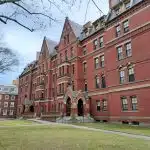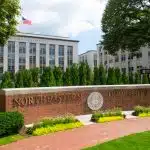Choosing a college is a big decision, and for many people, getting into one of the best schools is a dream. The US has many excellent universities that are known for groundbreaking research, rigorous academics, and lively campus life. In this article, we’ll look at the top universities in the US and what makes them stand out.
- What Are the Top Universities in the USA?
- Princeton University
- Massachusetts Institute of Technology
- Harvard University
- Stanford University
- Yale University
- California Institute of Technology
- Duke University
- Johns Hopkins University
- Northwestern University
- University of Pennsylvania
- Frequently Asked Questions
- Takeaways
What Are the Top Universities in the USA?
There are around 4,000 universities in the USA. For this list, we used the U.S. News Best National University Rankings and Best Global Universities Rankings to pick the top 10 institutions in the country.
Here’s a quick look at the college rankings in the US:
| School | US News Best National University Ranking | US News Best Global University Ranking |
| Princeton University | #1 | #16 |
| Massachusetts Institute of Technology | #2 | #2 |
| Harvard University | #3 | #1 |
| Stanford University | #4 | #3 |
| Yale University | #5 | #9 |
| California Institute of Technology | #6 | #23 |
| Duke University | #6 | #27 |
| Johns Hopkins University | #6 | #14 |
| Northwestern University | #6 | #24 |
| University of Pennsylvania | #10 | #15 |
The Best National University Rankings focus on U.S.-based schools and measure factors like graduation and retention rates, faculty resources, academic reputation, and student selectivity. The Best Global Universities Rankings, on the other hand, evaluate institutions worldwide, using criteria such as research performance, global and regional research reputation, and international collaboration.
Below, we’ll discuss more about why these are the top 10 universities in the USA.
Princeton University
Acceptance rate: 4.6%
Average GPA of accepted students: 3.94
Average test scores of accepted students: 1510-1560, 34-35
Princeton University maintains a strong focus on undergraduate education. In fact, despite being a major research institution, it has an undergrad enrollment of 5,727 students, resulting in a 5:1 student-to-faculty ratio. The residential college system further creates a close-knit community.
The university emphasizes independent work. In your junior and senior years, you’ll engage in independent research, which culminates in the senior thesis for A.B. students or a senior design project for B.S.E. students.
Another great thing that makes Princeton one of the top universities in the USA is that it has one of the best need-based financial aid programs in the country. It’s one of the few universities that is need-blind for all applicants, including international students.
It also has a “no-loan” policy, meeting 100% of a student’s demonstrated financial need with grants that don’t need to be repaid so that you can graduate with little to no debt.
Massachusetts Institute of Technology
Acceptance rate: 4.5%
Average GPA of accepted students: 4.2
Average test scores of accepted students: 1520-1570, 34-36
The motto of the Massachusetts Institute of Technology is “Mens et Manus,” Latin for “Mind and Hand.” This means that theoretical knowledge is always paired with practical, hands-on application, so you can expect to learn the principles of science and engineering while also being challenged to apply them to solve real-world problems.
This approach is also reinforced by programs like the Undergraduate Research Opportunities Program, where many students participate in research. In fact, 95% of MIT students are involved in research as undergrads.
As one of the top universities in the USA, the curriculum is rigorous. All students are required to take foundational courses in mathematics, physics, biology, and chemistry. However, this broad foundation is also combined with different humanities, arts, and social science courses to make sure you receive a well-rounded education.
Interestingly, the first semester at MIT is graded on a pass/no record basis. This gives first-year students a chance to adjust to the demanding academic environment without the pressure of letter grades. The school also has a 3:1 ratio of undergraduate students to faculty and instructional staff.
Harvard University
Acceptance rate: 3.6%
Average GPA of accepted students: 4.2
Average test scores of accepted students: 1500-1580, 34-36
Harvard University is the oldest operating university in the US, founded in 1636. A defining factor for Harvard is its huge endowment, which is the largest of any academic institution in the world. For the 2024 fiscal year, Harvard’s endowment reached $53.2 billion—$749 million of which was granted in financial aid and scholarships, while part of it was given to specific programs, departments, or other purposes.
The school’s academic rigor is well-known. The undergraduate population numbers only 7,103 students, which allows for a student-to-faculty ratio of 7:1. This ensures that you can engage in close mentorship with professors who are often leading experts in their fields.
It’s also impressive that Harvard has a graduation rate of 98%. As one of the top universities in the USA, it believes in intellectual vitality, which encourages curiosity, tough questions, and diverse perspectives.
Harvard’s residential college system is a big part of the undergraduate experience, with first-year students living in historic dorms in Harvard Yard before moving to one of the 12 upper-level “Houses.” This system fosters a strong sense of community and gives you a built-in support network.
Stanford University
Acceptance rate: 3.6%
Average GPA of accepted students: 3.9
Average test scores of accepted students: 1500-1560, 34-35
One of the biggest factors that sets Stanford University apart is its location in the heart of Silicon Valley, which encourages students and faculty to develop a strong entrepreneurial spirit alongside innovation. Programs like the Stanford Technology Ventures Program and the Center for Entrepreneurial Studies provide you with the resources, mentorship, and networking opportunities to turn your ideas into reality.
As one of the top universities in the USA, Stanford offers a flexible curriculum that lets you take on multiple majors, a secondary major, or create an individually-designed major in Engineering. There are also many interdisciplinary programs. These pathways allow you to design your own majors or combine seemingly unrelated fields of study.
Stanford is also affectionately known as “The Farm,” because of its origins on the former Palo Alto Stock Farm of its founders, Leland and Jane Stanford. The school’s founding grant actually states that a farm for learning agriculture should always be maintained on its lands. So, in 2014, the School of Earth, Energy & Environmental Sciences created the O’Donohue Family Stanford Educational Farm.
Yale University
Acceptance rate: 4.6.%
Average GPA of accepted students: 4.1
Average test scores of accepted students: 1500-1560, 33-35
Perhaps the most distinctive feature of undergraduate life at Yale University is its residential college system. All first-year students are assigned to one of 14 residential colleges, where they remain for their entire four years. Each college is like a smaller version of the university, having its own dining hall, library, gym, and social spaces. It is also led by a Head of College and a Dean, who are senior faculty and administrators who serve as academic and personal advisors.
Yale’s distributional requirements ensure that you have a broad knowledge of different subjects and intellectual approaches. Courses in language proficiency may even be fulfilled through a combination of coursework and study abroad opportunities.
Yale’s financial aid is also very generous. In fact, it’s the first private research university in the US to offer need-blind admissions and need-based financial aid for undergraduate students. Yale meets 100% of a student’s demonstrated financial need with grants and scholarships, not loans. Thanks to that, you can graduate with little to no debt from one of the top universities in the USA, which attracts aspiring students from different socioeconomic backgrounds.
California Institute of Technology
Acceptance rate: 2.3%
Average GPA of accepted students: 4.2
Average test scores of accepted students: 1530-1570, 35-36
The California Institute of Technology is a world-renowned science and engineering research institution. The school has an incredibly low student-to-faculty ratio of 3:1, so you can benefit from close mentorship and collaboration with professors who are leaders in their fields.
The academic environment is also famously rigorous, with a core curriculum in mathematics, physics, chemistry, and biology that all undergrads should complete.
It’s very common for undergraduates to participate in research (usually through the Summer Undergraduate Research Fellowships program) where they can work on individual projects with faculty mentors. Caltech also manages NASA’s Jet Propulsion Laboratory, giving you access to world-class facilities and the opportunity to contribute to space exploration missions.
Another distinct part of Caltech that makes it one of the top universities in USA is its Honor Code: “No member of the Caltech community shall take unfair advantage of any other member of the Caltech community.” This code of ethics allows for an unusual level of trust, including take-home, open-book exams, and 24-hour access to labs and facilities.
Duke University
Acceptance rate: 4.8%
Average GPA of accepted students: 3.94
Average test scores of accepted students: 1510-1570, 33-35
Duke University encourages students to explore beyond traditional disciplines. In fact, it offers Program II, an individualized degree program that basically lets you design your own major. Meanwhile, initiatives like Bass Connections and DukeEngage offer you hands-on, problem-focused learning opportunities that let you collaborate with faculty and peers to address complex societal issues both locally and globally.
As one of the top universities in the USA, Duke’s campus life is also as much a part of its identity as its academics. The university has a strong sense of community thanks to its required three-year on-campus residency. This requirement ensures that you’re deeply integrated into campus life.
The residential programs are actually designed to build tight-knit communities that value learning and give you opportunities to engage with faculty and bond with your peers. With a community that supports you, you’ll be able to enjoy Duke traditions like Midnight Breakfast and bench burning even more.
Johns Hopkins University
Acceptance rate: 5.7%
Average GPA of accepted students: 3.95
Average test scores of accepted students: 1530-1560, 34-35
Johns Hopkins University is legendary for being the country’s first research university. It’s also the first American university founded on the German model of integrating teaching and research. This has led to a long history of groundbreaking discoveries and innovations in medicine, including the development of CPR and the “blue baby” cardiac surgery.
As one of the top universities in the USA, Johns Hopkins is also known outside of medicine for its commitment to research and interdisciplinary study across other disciplines. The school has a flexible curriculum with a strong focus on individual student inquiry. In fact, there aren’t any mandatory core curriculum classes. Instead, you’ll have distribution requirements that encourage you to explore different areas of study.
Johns Hopkins also offers dual degrees at both the undergraduate and graduate levels. For example, you can get a Bachelor of Music or Bachelor of Fine Arts from the Peabody Institute while also working for a Bachelor of Arts or Bachelor of Science degree from the Krieger School of Arts and Sciences or the Whiting School of Engineering.
Northwestern University
Acceptance rate: 7%
Average GPA of accepted students: 4.1
Average test scores of accepted students: 1500-1560, 33-35
Northwestern University has a flexible academic structure that lets you pursue double majors, dual degrees, minors, and certificates. The school also operates on a quarter system, where the academic year is divided into four 10-week terms. This allows you to take more classes and explore a wider range of subjects than you could on a traditional semester schedule.
All these encourage intellectual curiosity and a breadth of knowledge, making students well-prepared for diverse career paths after graduating from one of the top universities in the USA.
Northwestern is also a founding member of the Big Ten Conference, and its student body has a lot of school spirit, especially for its athletics. The “Wildcat Growl and Claw” is a game-day tradition where fans rally to support their teams.
Of course, Northwestern traditions play a huge role in building a strong community. Some of the most famous ones include Painting the Rock, Dillo Day, and the Northwestern Dance Marathon.
University of Pennsylvania
Acceptance rate: 5.4%
Average GPA of accepted students: 3.9
Average test scores of accepted students: 1500-1570, 34-35
The University of Pennsylvania is one of the oldest universities in the country. It was founded in 1740 by Benjamin Franklin, who envisioned an institution that would teach practical knowledge and skills alongside the arts and humanities to prepare students to be engaged citizens and leaders in their communities. This vision has continued to shape the university, making it a hub for interdisciplinary studies and applied learning.
For example, UPenn offers dual-degree programs that combine fields from different schools, such as the Huntsman Program in International Studies and Business, or the Jerome Fisher Program in Management and Technology. These programs cater to students with uniquely specific interests that also address real-world problems.
As one of the top universities in the USA, UPenn also has a strong culture of innovation, with a focus on transforming knowledge into action. Programs like the President’s Engagement Prizes provide funding for graduating seniors to launch projects that serve society.
Frequently Asked Questions
1. What are the top public universities in the US?
Five of the top public universities in the US include UCLA, UC Berkeley, University of Michigan at Ann Arbor, University of Virginia, and University of North Carolina at Chapel Hill.
2. What are the Big 3 universities in the US?
The Big Three, also known as HYP, are Harvard University, Yale University, and Princeton University. This term started in the late 19th century, when the three aforementioned schools dominated college football.
3. What’s the hardest college to get into?
The hardest college to get into is currently Caltech, with an acceptance rate of only 2.3% for the Class of 2028.
Takeaways
- The top 10 universities in the USA are Princeton, MIT, Harvard, Stanford, Yale, Caltech, Duke, Johns Hopkins, Northwestern, UPenn.
- Beyond rigorous academics, these top universities also offer unique campus cultures, traditions, social environments, and generous financial aid.
- Do you see your dream school on the list? Talk to a college admissions expert to guide you in strengthening your college application and choosing which institutions are the best for your academic and professional goals.

Eric Eng
About the author
Eric Eng, the Founder and CEO of AdmissionSight, graduated with a BA from Princeton University and has one of the highest track records in the industry of placing students into Ivy League schools and top 10 universities. He has been featured on the US News & World Report for his insights on college admissions.




















